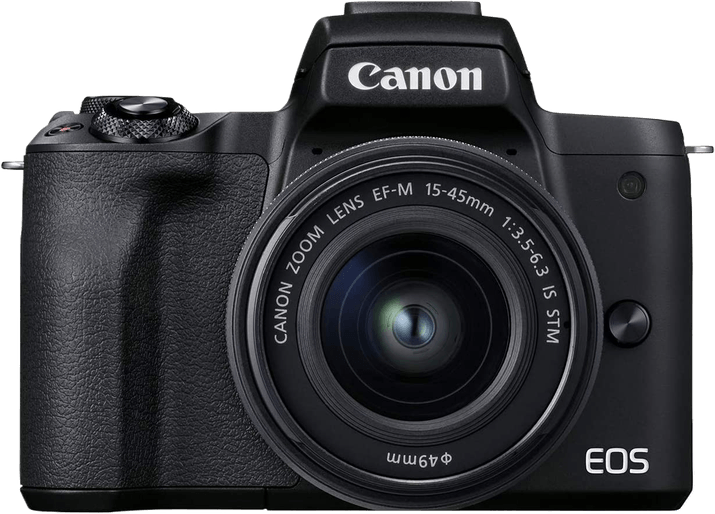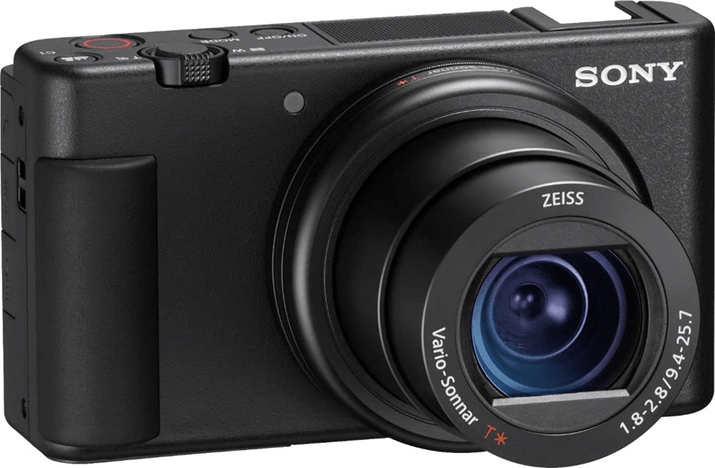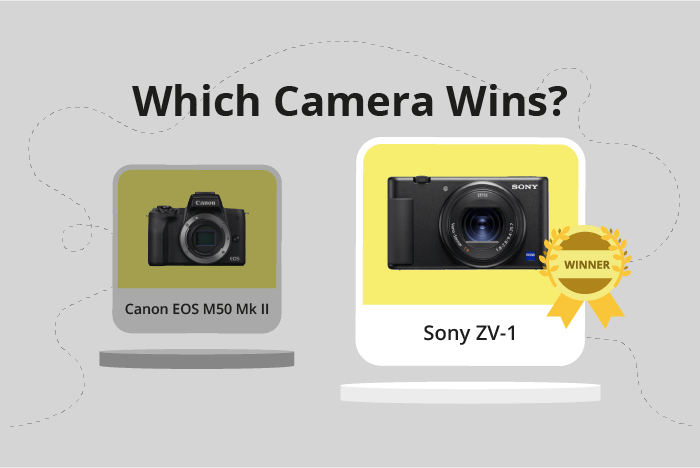Canon EOS M50 Mark II vs Sony ZV-1 Comparison
Canon EOS M50 Mark II

Sony ZV-1

The Sony ZV-1 takes a lead with a score of 65/100, while the Canon EOS M50 Mark II trails behind at 59/100. Both cameras were announced in 2020, with the Sony ZV-1 being a compact camera and the Canon EOS M50 Mark II being a mirrorless camera. They share similar launch prices, with the Sony ZV-1 priced at $800 and the Canon EOS M50 Mark II at $750.
The Sony ZV-1 is better in terms of its smaller size and lighter weight, measuring 105 x 60 x 44mm and weighing 294g, compared to the Canon EOS M50 Mark II’s dimensions of 116 x 88 x 59mm and weight of 387g. This makes the Sony ZV-1 more portable and convenient for on-the-go photography.
The Canon EOS M50 Mark II, on the other hand, offers the advantage of being a mirrorless camera, which can provide better image quality and a wider range of lens options. This makes it more suitable for photographers who prioritize image quality and versatility.
Taking these factors into account, the Sony ZV-1 is the better choice for those who prioritize portability, while the Canon EOS M50 Mark II is more suitable for photographers seeking higher image quality and lens options.
Canon EOS M50 Mark II vs Sony ZV-1 Overview and Optics
The Sony ZV-1 outperforms the Canon EOS M50 Mark II in optics, scoring 67/100 compared to the Canon’s 59/100. Both cameras have a CMOS sensor and similar megapixels, with the Canon EOS M50 Mark II having 24 megapixels and the Sony ZV-1 having 20 megapixels. Both cameras are capable of producing high-quality images.
The Sony ZV-1 exceeds the Canon EOS M50 Mark II in several aspects. It has a faster shooting speed of 24 compared to the Canon’s 10, allowing for quicker capture of subjects and improved performance in action photography. The Sony ZV-1 also has a higher DXOMARK score for its sensor at 82, while the Canon EOS M50 Mark II scores 58, which means the Sony ZV-1 delivers superior image quality. Additionally, the Sony ZV-1 has image stabilization, which reduces camera shake and results in sharper images.
On the other hand, the Canon EOS M50 Mark II has a larger APS-C sensor compared to the Sony ZV-1’s 1″ sensor. This allows for better low-light performance and dynamic range. The Canon EOS M50 Mark II also has a lens mount, the Canon EF-M, which enables users to change lenses for different shooting scenarios and creative purposes.
However, the Sony ZV-1 uses a fixed lens mount, restricting users to the built-in lens. Despite this limitation, the Sony ZV-1 remains a strong choice for those who prioritize image quality, shooting speed, and image stabilization.
Considering the specifications, the Sony ZV-1 is the superior option in terms of optics due to its higher score, faster shooting speed, better sensor performance, and image stabilization. The Canon EOS M50 Mark II may still appeal to users who value low-light performance and lens interchangeability.
Canon EOS M50 Mark II vs Sony ZV-1 Video Performance
The Canon EOS M50 Mark II and the Sony ZV-1 both have a video score of 91/100, making them equally impressive in terms of video capabilities. These cameras share several common specifications, such as 4K max video resolution, 3840 x 2160 max video dimensions, a 120fps max video frame rate, and built-in time-lapse functionality.
Despite the identical video scores, there are areas where one camera may outperform the other. The Canon EOS M50 Mark II is known for its versatility and user-friendly design, making it an excellent choice for beginners and enthusiasts alike. The camera’s ergonomic structure and intuitive interface provide a seamless video recording experience. Additionally, the Canon EOS M50 Mark II is compatible with a wide range of Canon lenses, allowing for further customization and improved video quality.
On the other hand, the Sony ZV-1 is a compact camera specifically designed for vloggers and content creators. It features a fast hybrid autofocus system that ensures sharp and precise focus during video recording. The camera also includes a built-in ND filter, allowing for better control over exposure in various lighting conditions. Furthermore, the Sony ZV-1 has a 3-inch vari-angle touchscreen that simplifies framing and monitoring while recording videos.
Both cameras excel in their video capabilities, but each shines in different ways. The Canon EOS M50 Mark II is a versatile and user-friendly option, while the Sony ZV-1 is tailored for vlogging and content creation, with advanced features like a fast autofocus system and built-in ND filter. Choosing between these cameras ultimately depends on the user’s specific needs and preferences.
Canon EOS M50 Mark II vs Sony ZV-1 Features and Benefits
The Canon EOS M50 Mark II wins the features comparison with a score of 70/100, while the Sony ZV-1 scores 68/100. Both cameras share several specifications, such as a 3-inch touchscreen, flip screen, WIFI, and Bluetooth connectivity. Neither camera has GPS.
The Canon EOS M50 Mark II is superior due to its higher screen resolution of 1,040,000 dots, compared to the Sony ZV-1’s 921,600 dots. This higher resolution translates to a sharper and clearer display, which allows for better image preview and easier menu navigation.
The Sony ZV-1 has its advantages, but they do not contribute to a higher feature score. It is important to consider other aspects, such as price, performance, and personal preferences when choosing between these two cameras.
After comparing the features of both cameras, the Canon EOS M50 Mark II emerges as the winner due to its higher screen resolution. However, the Sony ZV-1 remains a competitive option with only a slight difference in the overall score. Ultimately, the choice between these two cameras should be based on individual needs and priorities, as both offer similar specifications and features.
Canon EOS M50 Mark II vs Sony ZV-1 Storage and Battery
The Sony ZV-1 wins in the storage and battery category with a score of 29, while the Canon EOS M50 Mark II scores 21. Both cameras have one memory card slot and accept SD, SDHC, and SDXC cards. However, the Sony ZV-1 also accepts Memory Stick Pro Duo and Pro-HG Duo cards, offering more storage compatibility.
The Canon EOS M50 Mark II has a longer battery life of 305 shots, compared to the Sony ZV-1’s 260 shots. Despite this advantage, the Sony ZV-1 has the added benefit of USB charging, making it more convenient for users who need to charge on-the-go.
In terms of storage and battery, the Sony ZV-1 is the better choice due to its versatile memory card compatibility and USB charging capabilities. While the Canon EOS M50 Mark II offers slightly better battery life, it lacks USB charging, which may be a crucial factor for some users.
Canon EOS M50 Mark II vs Sony ZV-1 – Our Verdict
Are you still undecided about which camera is right for you? Have a look at these popular comparisons that feature the Canon EOS M50 Mark II or the Sony ZV-1:

